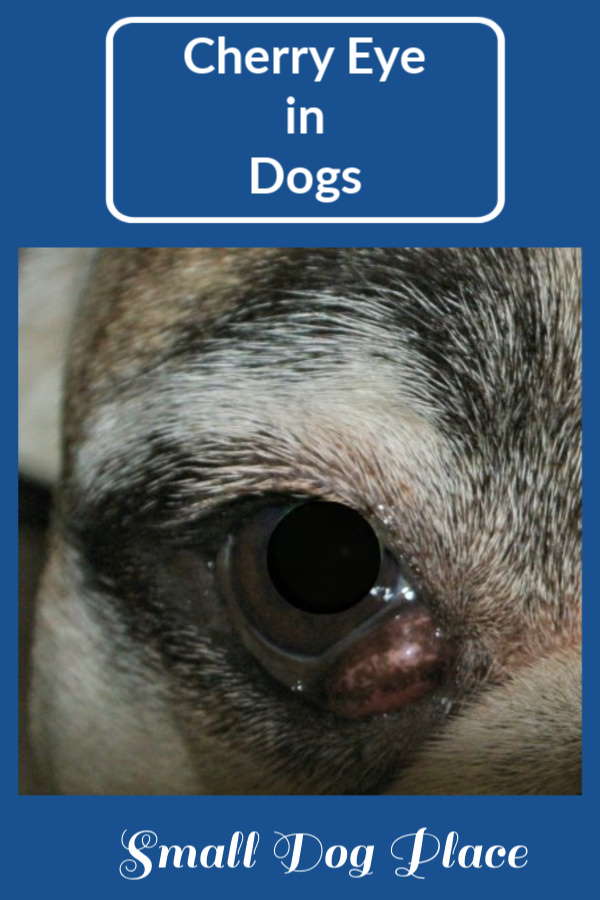What is a Cherry Eye?
Cherry Eye By Janice Jones M.A. |Last Updated 04-06-2020
Whether you believe that a cherry eye is a cosmetic problem or a serious medical condition, you probably have to agree that it is not the easiest sight to behold.
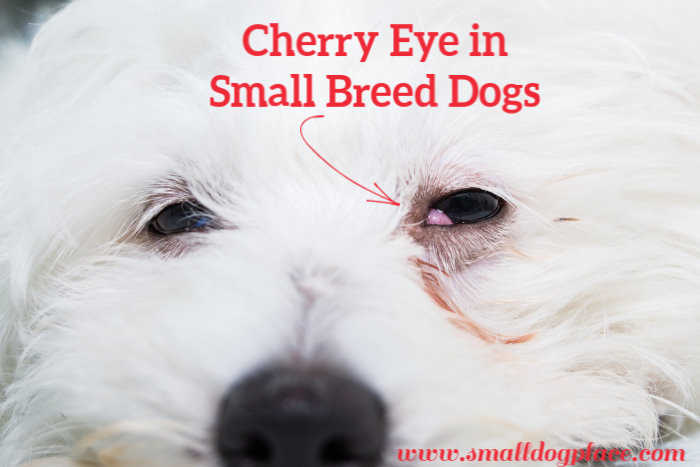 Cherry Eye in Small Breed Dogs
Cherry Eye in Small Breed DogsGetting its name from the fact that it seems to resemble a bright red cherry, the correct medical term for this odd looking mass is a prolapse gland of the third eyelid or nictitating membrane. This is an important structure of the eye because it assists in spreading the precorneal tear film over the eye to protect it from injury.
This condition is normally seen in younger dogs but if it occurs in older dogs, the cause is likely some type of neoplasia of the third eyelid.
Unlike people, dogs have a third eyelid or membrane that contains the glands that produce tears. When the tissue that holds these glands weakens, they will pop out so what you see is a small mass which looks like a cherry.
Once the gland pop is out and visible, it can become swollen and even become infected.
You would think that a cherry eye is painful to the dog, but it usually is not. The main problem that unfolds is the lack of adequate tear production to lubricate the eye, causing the dog to experience a dry eye.
However, this is not always the case because as long as the gland is still intact, tear production continues.
Dog Breeds Affected
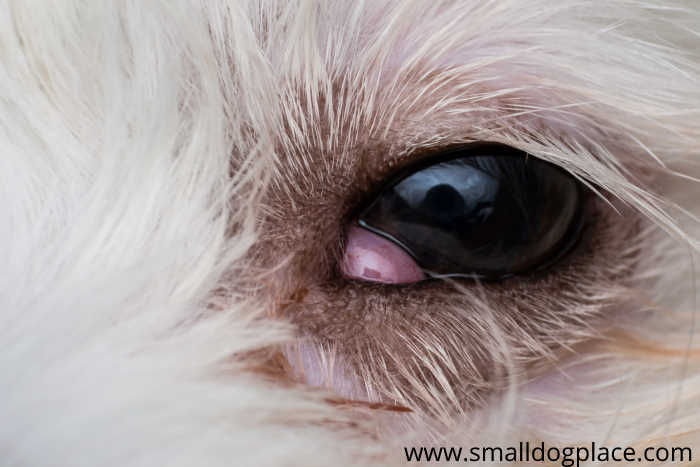
Cherry eye is common in small dogs, especially young ones. Breeds with short muzzles such as Boxers, Bulldogs, Pugs, and Boston terriers are more prone to developing this condition.
But it is also seen in Beagles, Lhasa Apso, West Highland White Terriers, Cocker Spaniels., and Cavalier King Charles Spaniels. I
It can also occur in cats, but with less frequency.
There seems to be some disagreement as to whether it is a problem that needs to be fixed or simply a cosmetic issue causing the dog to have a rather peculiar appearance.
There even seems to be controversy over whether the membrane should be removed or just tucked back into place.
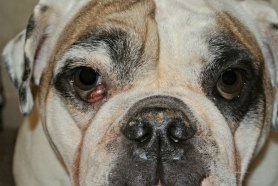 This is a picture of my four-year-old English Bull Dog, “Helda-lot.” She never seemed bothered by that ugly mass.
This is a picture of my four-year-old English Bull Dog, “Helda-lot.” She never seemed bothered by that ugly mass.Signs and Symptoms of Cherry Eye
The only symptom is the noticeable red circular mass that protrudes from the side of the dog’s eye. This swollen membrane in the corner of the dog's eye often appears suddenly and unexpectedly.
Sometimes dogs will rub or paw at their eye which can irritate it further. In other cases, the dog does not appear to be bothered by it and it is generally assumed to not cause pain.
It can occur in one or both eyes.
When the tissue is exposed, it can It can lead to bacterial infections. trauma, and swelling.
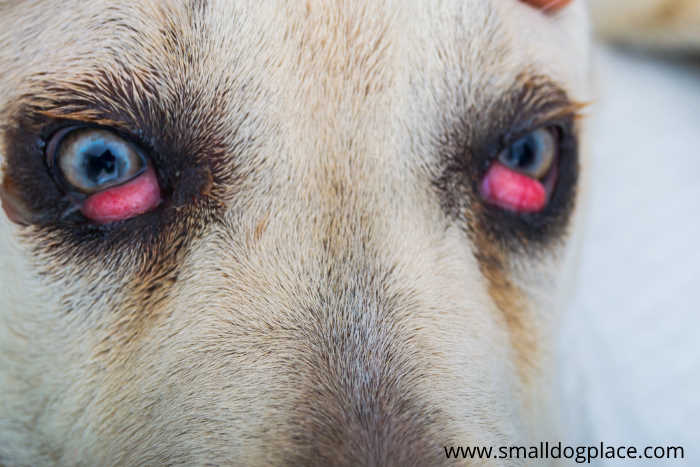 Cherry Eye in both Eyes
Cherry Eye in both EyesCommon Signs
- Circular red mass protruding from one side of the eye.
- Swelling
- Discharge
- Eye infection
- Irritation
- Possible discomfort
- Dry Eye
Causes
Since the condition seems to follow certain breed lines, it is likely an inherited problem. According to Dr. Karen Becker, the cause isn’t well understood.
It is however believed to be weakness of the connective tissue ligaments that holds the glands in place. Stress or trauma to the area are also possible causes especially in dogs that already have a genetic susceptibility.
Diagnosis
The veterinarian will make a diagnosis after observing the mass. Tumors need to be ruled out if the dog is older and the veterinarian will also take breed into consideration when making the diagnosis.
Treatment
Treatment options can fall into two categories: medical and surgical. Of course, the other option is to do nothing.
Medical Interventions
Medical interventions sometimes work if they are begun immediately after the gland pops out. Antibiotic and Steroid eye drops are often prescribed but may prove to be ineffective. Medical treatment is often prescribed as a way to alleviate the problem without the cost of the surgery.
Surgical Treatment
If medical treatment fails, it’s time for surgery. There are three options available. Veterinarians can suture the gland back where it belongs or they can remove it entirely.
Another option is called a pocket procedure where two small incisions are made. Then, the membrane is inserted into the "pocket." This surgery allows the membrane and the tear ducts to remain intact. If the third eyelid or membrane becomes dislodged again, the surgery will need to be repeated.
A partial removal technique will remove only the affected area and leave the rest intact. The vet will try to save as much of the tear duct as possible, but there is still a chance that the membrane will become inflamed again at some point. Dry eye is also a possibility. More about dry eye in a moment.
If your veterinarian chooses to remove the gland, the dog may be susceptible to dry eye or Keratoconjunctivitis sicca or KCS. This is a chronic degenerative conjunctivitis that does not have a favorable outcome, leading to vision problems and blindness.
If this happens the cornea dries out due to
inadequate tears. Owners must apply eye
drops daily to keep the eye lubricated; otherwise the vision is likely to be
affected in the eye.
Regardless of the type of surgery, general anesthesia is required. Most of the surgeries to correct Cherry Eye are fast and have very few complications.
Most animals go home the same day after they recuperate from anesthesia. After the surgery, some animals are prescribed antibiotics and anti-inflammatory medications and antibiotic eye drops are recommended.
The worst part of the surgery in the dog's mind is having to wear the dreaded e-collar (commonly called the cone of shame) until the eye heals. Some dogs will not bother the eye by pawing and scratching, but that is rare, so it is better to be safe (with a collar) than without one.
Costs Associated with Surgery
According to Embrace Health Insurance a typical surgery can run from $500 to $650 which would include the surgery, anesthesia and accompanying medications.
References
Common Diseases of Companion Animals by Alleice Summers, 3rd Ed.
https://www.bulldogology.net/bulldog-cherry-eye-treatments/
About Janice (author and voice behind this site)
Having lived with dogs and cats most of her life, Janice served as a veterinary technician for ten years in Maryland and twelve years as a Shih Tzu dog breeder in Ohio.
Her education includes undergraduate degrees in Psychology with a minor in biology, Early Childhood Education, and Nursing, and a master's in Mental Health Counseling.
She is a lifelong learner, a dog lover, and passionate about the welfare of animals. Her favorite breed for over 50 years has been the Shih Tzu, but she has also lived with Poodles, Maltese, Yorkshire Terriers, Beagles, English Bulldogs, Carin Terriers, and a Cocker Spaniel.
When not writing, reading, and researching dog-related topics, she likes to spend time with her eight Shih Tzu dogs, husband, and family, as well as knitting and crocheting. She is also the voice behind Miracle Shih Tzu and Smart-Knit-Crocheting
Does This Article Deserve Your Thumbs Up?
We always appreciate your support and encouragement. Your thumbs up means so much to us. Please like this article.
If you find this page or any page on Small Dog Place Helpful, or useful in anyway, I'd love it if you would click the small heart found on the bottom right of each page.
You can also share or bookmark this page -- just click on the:

Free Monthly Newsletter
Sign Up for Our Free Newsletter and get our Free Gift to You.
my E-book, The Top 10 Mistakes People Make When Choosing a Dog (and how to avoid them)
